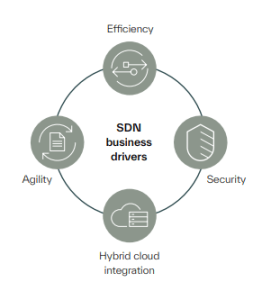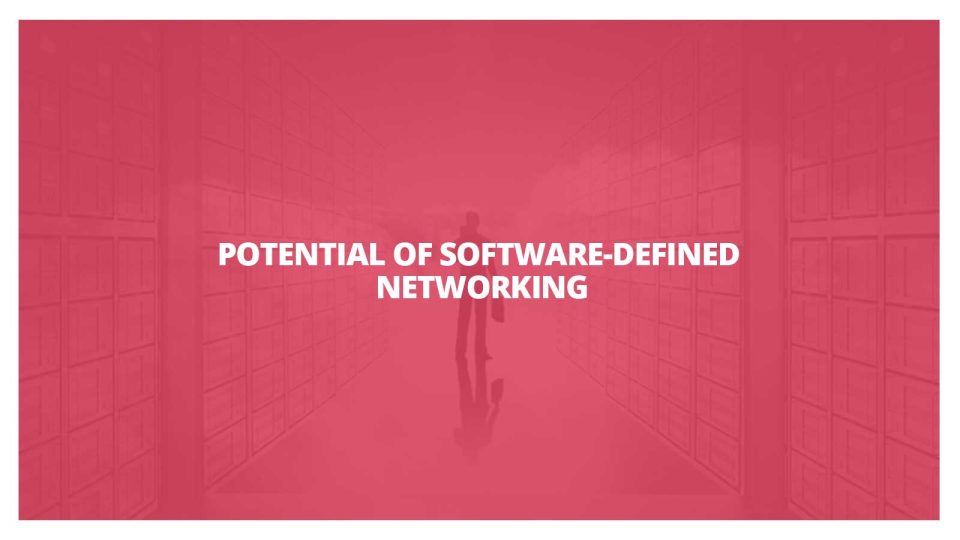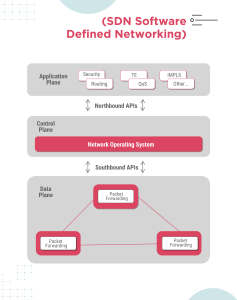Software-defined networking refers to the radical change in network architecture that has been gaining prominence in the current information technology scenario. This solution uses software programs to manage the flow of traffic in the network, unlike traditional hardware-based methods of operation.
By 2028, the SDN market is forecast to grow over 60 billion U.S. dollars with a compound annual growth rate of over 19 percent from 2023 to 2028. – Statista Report
SDN works on a centralized platform orchestrating with different IT infrastructures through APIs. The network traffic is handled in an effective way by creating an abstraction of a virtual overlay network on top of a physical underlay network. This now enables delivery of the application environments as code, thereby bringing down the manual tasks of network management to almost zero.
 SDN allows firms to extend cloud benefits to network management and deployment. Virtualization of the network will introduce more efficiency in companies and be more harmonious with cloud services like SaaS and IaaS. In this respect, APIs play a big role in integrating SDN for better functionality.
SDN allows firms to extend cloud benefits to network management and deployment. Virtualization of the network will introduce more efficiency in companies and be more harmonious with cloud services like SaaS and IaaS. In this respect, APIs play a big role in integrating SDN for better functionality.
SDN enhances the flexibility and clarity of the visible network. Again, unlike traditional setups where devices like routers and switches are only aware of their surroundings, SDN centralized all the information. It gives immense readability and control over the whole infrastructure. Additionally, because of SDN, one can have segmentation of virtual networks in a single physical network or unification of multiple physical networks into one virtual network, giving flexibility and adaptability without comparison with any other technology.
Also Read: Web3 and Depin, the New Infrastructure Juggernaut
SDN Architecture
SDN architecture comprises various components, each with specific functions. Let’s examine these SDN architecture components and their roles individually. The fundamental SDN components include:
- Network Devices (Data Plane)
- SDN Controller (Control Plane)
- Southbound Interface
- Northbound Interface
- Network Operating System (NOS)
- Applications and Services (Application Plane)
Types of SDN
There are four primary types of software-defined networking:
- Open SDN: Open protocols are used to control virtual and physical devices responsible for routing data packets. This approach facilitates collaboration among network operators, developers, and vendors for optimization.
- API SDN: Controls data flow to and from each device through programming interfaces, often called southbound APIs. This type allows orchestration platforms, cloud management tools, and network management systems to integrate with SDN infrastructure.
- Overlay Model SDN: Runs virtual networks over existing hardware, creating tunnels with channels to both remote and on-premises data centers. It allocates bandwidth and assigns devices to each channel.
- Hybrid Model SDN
- Combines SDN with traditional networking, assigning the optimal protocol for each type of traffic. This model is often used as an incremental approach, enabling enterprises to integrate SDN into legacy environments.
Distinguishing SDN from Traditional Networking
There are three key differences between Software-Defined Networking (SDN) and traditional networking:
- Control and Communication Interfaces: SDN utilizes a northbound interface in its controller to communicate with applications via application programming interfaces (APIs). This allows application developers to program the network directly. In contrast, traditional networking relies on established protocols for communication.
- Network Infrastructure: SDN operates as a software-based network, enabling users to manage virtual resource allocation through the control plane and configure network services proactively. Traditional networking depends on physical infrastructure, such as switches and routers, to establish and maintain connections.
- Centralized Management and Control: SDN offers enhanced communication with network devices, allowing resources to be provisioned from a central location. Administrators can control traffic flow through a centralized user interface, providing rigorous oversight and greater control over network capabilities. Traditional networking, however, has its control plane embedded within individual switches or routers, making it less accessible for administrators to manage traffic flow effectively.
Also Read: CIO Influence Interview with Ben Oster, VP of Product Management at WatchGuard Technologies
Advantages of SDN
The centralization of network control and management in SDN architecture brings numerous advantages:
1. Simplified Network Management
By separating packet forwarding from the data plane, SDN allows for direct programming and easier control of the network. This includes real-time configuration of network services like Ethernet and firewalls and quick allocation of virtual network resources from a centralized location.
2. Increased Agility
SDN enables dynamic load balancing to manage traffic flow based on need and usage fluctuations, reducing latency and increasing network efficiency.
3. Enhanced Flexibility
A software-based control layer provides network operators with greater flexibility to control the network, modify configuration settings, provision resources, and expand network capacity.
4. Improved Security Management
SDN allows administrators to set policies from a central location to determine access control and security protocols across the network by workload type or network segment. Micro-segmentation reduces complexity and ensures consistency across any cloud architecture, whether public, private, hybrid, or multi-cloud.
5. Streamlined Network Design and Operation
Administrators can use a single protocol to communicate with various hardware devices through a central controller. This flexibility allows organizations to choose networking equipment freely, often opting for open controllers over vendor-specific devices and protocols.
6. Telecommunications Modernization
Combining SDN technology with virtual machines and network virtualization, service providers can offer distinct network separation and control to customers. This enhances scalability and provides bandwidth on demand for customers with variable usage needs.
SDN Use Cases
Network Virtualization
Network virtualization is a leading SDN application, transforming how networks are managed and secured. Initially popularized by Nicira, this approach automates network creation and management, which is essential for modern cloud environments. Key benefits include:
- Automation: Programmatically creating, managing, and dismantling virtual networks.
- Security: Enhancing network security through features like micro-segmentation, reducing attack surfaces.
- Scalability: Supporting dynamic workloads and container-based systems like Kubernetes with various open-source plugins.
Switching Fabrics
In cloud data centers, pure-play SDN optimizes switching fabrics using bare-metal switches controlled by software. These fabrics, often organized in a leaf-spine topology, improve cost-efficiency and feature velocity. This setup ensures multiple paths for redundancy and optimal traffic flow, which is crucial for large-scale data operations.
Traffic Engineering for WANs
Traffic engineering in wide-area networks (WANs) benefits significantly from SDN. Companies like Google and Microsoft use SDN to manage traffic between data centers, achieving near-optimal link utilization and enhancing network efficiency. Centralized control allows for real-time traffic management and path optimization, supporting various application needs and traffic classes.
Key Players in the SDN Market
Cisco
Hewlett-Packard
Huawei
Juniper Networks
Nokia
VMware
IBM
NEC
Dell EMC
Microsoft Azure Case study: SDN for Cloud Services
Microsoft integrated SDN into its Azure cloud platform to improve service delivery and scalability for its global customer base.
Challenges:
- Scaling network infrastructure to support the expanding Azure services.
- Ensuring secure, isolated, and efficient communication between virtual networks.
- Managing complex network configurations and policies.
Solution:
- Implemented SDN using Network Controller and Virtual Network.
- Utilized Network Virtual Appliances (NVAs) for enhanced security and traffic management.
- Deployed Azure Virtual Network to provide isolated, scalable networks for different tenants.
Outcomes:
- Simplified network management and policy enforcement.
- Increased scalability and flexibility for Azure services.
- Enhanced security and isolation between virtual networks.
Conclusion
The future of Software-Defined Networking (SDN) is promising as the technology matures and gains wider adoption. Currently, cloud-hosted control planes are becoming more common, and SDN’s application to access networks is emerging. As APIs stabilize, broader adoption of various use cases is expected, transforming network functionality in ways traditional networks cannot achieve.
Network verification is a significant opportunity for SDN. Traditional networks are challenging in ensuring robustness and security against failures, attacks, and configuration errors. The advent of 5G, connecting diverse devices from smartphones to self-driving cars, will further complicate this landscape. SDN’s ability to state network-level intent and observe behavior in real-time enhances verifiability, making secure and reliable closed-loop control achievable.
[To share your insights with us as part of editorial or sponsored content, please write to psen@itechseries.com]



